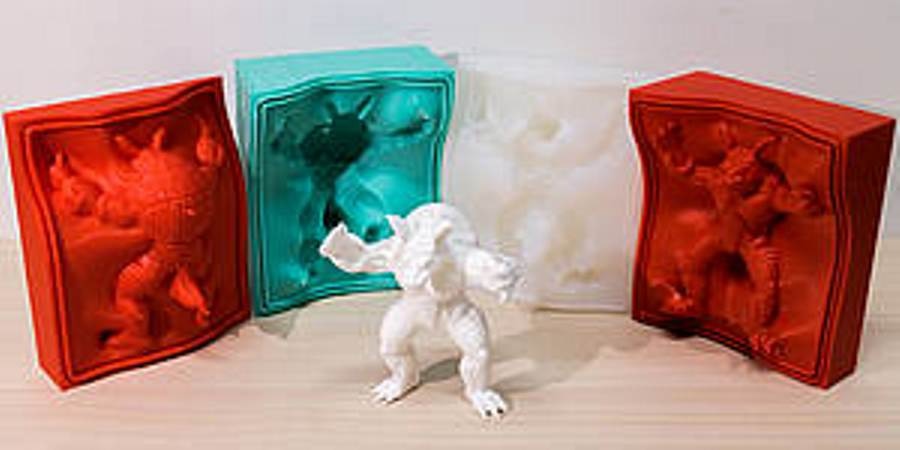Aug 23 2018
It has been a long-standing tradition to fabricate objects through silicone molding. However, until now, fabricating molds for casting complex objects demanded plenty of experience and also involved manual work, which made the process both slow and expensive.
 Fabrication of an object using metamolds. The metamolds (red pieces far left and right) are used to fabricate the silicone molds (greenish and white shapes in the middle). The silicone can then be used repeatedly to form replicas (front). (Image credit: Luigi Malomo)
Fabrication of an object using metamolds. The metamolds (red pieces far left and right) are used to fabricate the silicone molds (greenish and white shapes in the middle). The silicone can then be used repeatedly to form replicas (front). (Image credit: Luigi Malomo)
Now a tool has been developed by scientists from the Istituto di Scienza e Tecnologie dell’Informazione (ISTI-CNR) and the Institute of Science and Technology Austria (IST Austria) that automatically identifies the best method to design the molds and even provides templates for so-called “metamolds” - 3D-printed rigid molds that are used for creating the optimized silicone molds. The researchers’ latest technique, which can reduce the cost of the traditional fabricating method, was presented at this year’s prominent SIGGRAPH conference where IST Austria scientists are taking part in a total of five presentations.
The molding technique is playing a major role when it comes to creating a range of identical objects. Silicone is one of the preferred materials for the mold, because it can be easily deformed and thus forgiving when it comes to obtaining intricate objects from the mold toward the end of the fabrication process. When extracting the object from the silicone mold, a direction has to be generally decided in which the pieces of mold can be taken apart without getting caught in the object’s overhanging parts. The mold is opened by placing a careful cut. Earlier, this process involved manual work from a skilled craftsman, but now it has been automated.
Until now, silicone molding of complex shapes was a craft that needed years of experience and a skillful hand. You needed to know where to place the cuts ideally and the work was done manually. Our new tool makes this method accessible for everyone.
Bernd Bickel
All the user needs to do is to upload the preferred shape to the computer. The tool subsequently aids in two steps - first, it determines where the cuts have to be placed to achieve an optimal outcome. This means that it is possible to use the smallest possible number of mold pieces and the object can be easily and safely removed from the mold after it is finished. The computer then goes one step further - it automatically produces the 3D-printable templates of the metamold, a type of container used for creating the perfect silicone mold pieces. Liquid silicone is added to the printed metamolds to create the final silicone mold pieces, which can be reused and allowed to cast numerous replicas.
The scientists hope that that their approach will prove extremely useful for small series, for instance in art or jewelry design.
“When you are not producing millions of copies, then this is the method of choice,“ states Thomas Alderighi from ISTI-CNR, the study’s first author who spent two months as an intern in the research group of Bernd Bickel at IST Austria.
As observed by Paolo Cignoni, research director at ISTI – CNR, one fascinating field of application would be to allow visitors to create a small number of replicas for museums to get a deeper experience of the exhibition.
The final silicone mold pieces can subsequently be used for creating replicas from a range of different materials such as conventional ones like different types of resin as well as unconventional ones like ice or chocolate.